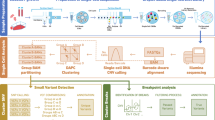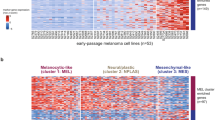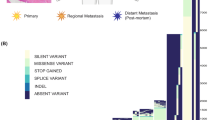Abstract
Background
The tissue of origin of the cell line MDA-MB-435 has been a matter of debate since analysis of DNA microarray data led Ross et al. (2000, Nat Genet 24(3):227–235) to suggest they might be of melanocyte origin due to their similarity to melanoma cell lines. We have previously shown that MDA-MB-435 cells maintained in multiple laboratories are of common origin to those used by Ross et al. and concluded that MDA-MB-435 cells are not a representative model for breast cancer. We could not determine, however, whether the melanoma-like properties of the MDA-MB-435 cell line are the result of misclassification or due to transdifferention to a melanoma-like phenotype.
Methods
We used karyotype, comparative genomic hybridization (CGH), and microsatalite polymorphism analyses, combined with bioinformatics analysis of gene expression and single nucleotide polymorphism (SNP) data, to test the hypothesis that the MDA-MB-435 cell line is derived from the melanoma cell line M14.
Results
We show that the MDA-MB-435 and M14 cell lines are essentially identical with respect to cytogenetic characteristics as well as gene expression patterns and that the minor differences found can be explained by phenotypic and genotypic clonal drift.
Conclusions
All currently available stocks of MDA-MB-435 cells are derived from the M14 melanoma cell line and can no longer be considered a model of breast cancer. These cells are still a valuable system for the study of cancer metastasis and the extensive literature using these cells since 1982 represent a valuable new resource for the melanoma research community.




Similar content being viewed by others
Abbreviations
- CGH:
-
Comparative Genomic Hybridisation
- SNP:
-
Single Nucleotide Polymorphism
- STR:
-
Short Tandem Repeat
References
Ross DT, Scherf U, Eisen MB, Perou CM, Rees C, Spellman P et al (2000) Systematic variation in gene expression patterns in human cancer cell lines. Nat Genet 24(3):227–235
Thompson EW, Waltham M, Ramus SJ, Hutchins AM, Armes JE, Campbell IG et al (2004) LCC15-MB cells are MDA-MB-435: a review of misidentified breast and prostate cell lines. Clin Exp Metastasis 21(6):535–541
Sellappan S, Grijalva R, Zhou X, Yang W, Eli MB, Mills GB et al (2004) Lineage infidelity of MDA-MB-435 cells: expression of melanocyte proteins in a breast cancer cell line. Cancer Res 64(10):3479–3485
Lee H, Lin EC, Liu L, Smith JW (2003) Gene expression profiling of tumor xenografts: in vivo analysis of organ-specific metastasis. Int J Cancer 107(4):528–534
Jessani N, Liu Y, Humphrey M, Cravatt BF (2002). Enzyme activity profiles of the secreted and membrane proteome that depict cancer cell invasiveness. Proc Natl Acad Sci 99(16):10335–10340
Ellison G, Klinowska T, Westwood RF, Docter E, French T, Fox JC (2002) Further evidence to support the melanocytic origin of MDA-MB-435. Mol Pathol 55(5):294–299
Rae JM, Ramus SJ, Waltham M, Armes JE, Campbell IG, Clarke R et al (2004) Common origins of MDA-MB-435 cells from various sources with those shown to have melanoma properties. Clin Exp Metastasis 21(6):543–552
Garraway LA, Widlund HR, Rubin MA, Getz G, Berger AJ, Ramaswamy S et al (2005) Integrative genomic analyses identify MITF as a lineage survival oncogene amplified in malignant melanoma. Nature 436(7047):117–122
Creighton C, Kuick R, Misek DE, Rickman DS, Brichory FM, Rouillard JM et al (2003) Profiling of pathway-specific changes in gene expression following growth of human cancer cell lines transplanted into mice. Genome Biol 4(7):R46
Saldanha AJ (2004) Java treeview––extensible visualization of microarray data. Bioinformatics 20(17):3246–3248
Eisen MB, Spellman PT, Brown PO, Botstein D (1998) Cluster analysis and display of genome-wide expression patterns. Proc Natl Acad Sci 95(25):14863–14868
Barch MJ, Knutsen T, Spurbeck J (eds) (1997) The AGT cytogenetics laboratory manual, 3rd edn. Lippincott, Philadelphia
Shaffer LG, Tommerup N (eds) (1995) International system for human cytogenetic nomenclature. Karger, Basel
Figueiredo BC, Stratakis CA, Sandrini R, DeLacerda L, Pianovsky MA, Giatzakis C et al (1999) Comparative genomic hybridization analysis of adrenocortical tumors of childhood. J Clin Endocrinol Metab 84(3):1116–1121
Satya-Prakash KL, Pathak S, Hsu TC, Olive M, Cailleau R (1981) Cytogenetic analysis on eight human breast tumor cell lines: high frequencies of 1q, 11q and HeLa-like marker chromosomes. Cancer Genet Cytogenet 3(1):61–73
Cailleau R, Olive M, Cruciger QV (1978) Long-term human breast carcinoma cell lines of metastatic origin: preliminary characterization. In Vitro 14(11):911–915
Price JE, Polyzos A, Zhang RD, Daniels LM (1990) Tumorigenicity and metastasis of human breast carcinoma cell lines in nude mice. Cancer Res 50(3):717–721
Chee DO, Boddie AW, Roth JA, Holmes EC, Morton DL (1976) Production of melanoma-associated antigen(s) by a defined malignant melanoma cell strain grown in chemically defined medium. Cancer Res 36(4):1503–1509
Katano M, Saxton RE, Cochran AJ, Irie RF (1984) Establishment of an ascitic human melanoma cell line that metastasizes to lung and liver in nude mice. J Cancer Res Clin Oncol 108(2):197–203
This work was supported in part by the Breast Cancer Research Foundation grant N003173 and and by U-01 GM61373 from the National Institute of General Medical Sciences, Bethesda, MD.
Author information
Authors and Affiliations
Corresponding author
Rights and permissions
About this article
Cite this article
Rae, J.M., Creighton, C.J., Meck, J.M. et al. MDA-MB-435 cells are derived from M14 Melanoma cells––a loss for breast cancer, but a boon for melanoma research. Breast Cancer Res Treat 104, 13–19 (2007). https://doi.org/10.1007/s10549-006-9392-8
Received:
Accepted:
Published:
Issue Date:
DOI: https://doi.org/10.1007/s10549-006-9392-8




